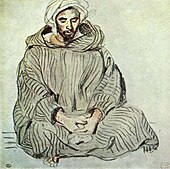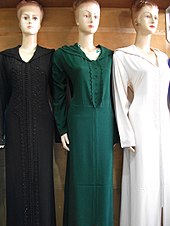Djellaba


The Djellaba ( Arabic جلابة, DMG ǧallāba , Zentralatlas-Tamazight ⴰⵙⵍⵀⴰⵎ Aselham, Selham ), also Dschellaba or Galabiya, is a traditional floor-length and hooded coat with long sleeves in the countries of the Maghreb , particularly in Morocco, which largely conceals the body contours . It differs from the Egyptian Galabija by a sewn-on pointed hood .
history
Since when the djellaba has existed in its current form and whether the djellaba is of Berber or Arab origin has not yet been researched. Older European paintings or photos from the Maghreb rarely show men in djellabas, but mostly in a hooded coat that is open at the front and only buttoned at the neck, or in a tunic with a separate scarf, headscarf or turban.
use
While the djellabas were originally simple, rather dark, but warming everyday robes for men's activities outside the home, white djellabas gradually developed into representative robes of high-ranking personalities. Maybe only since the middle of the 20th century there have been djellabas made of fine fabrics and in subtly bright colors as festive garments. In contrast to his father Hassan II , who preferred European clothing, the Moroccan King Mohammed VI wears . the white Djellaba often and happily on official occasions.
Men's robe
Djellabas for men were traditionally mostly made from simple new wool with the addition of goat hair; they could be mottled or striped. In everyday life they form a simple but practical and durable throw. High-ranking or wealthy personalities often afforded pure white djellabas (sometimes also with white embroidery), which they wore on festive occasions or for Friday prayers . In the 20th century, monochrome djellabas made of cotton fibers dyed in dark tones gradually appeared . Seams and seams are elaborately processed .
Women's robe
Since women - apart from fetching water - traditionally stayed in the house, djellabas only became known as women's robes in cities around the middle of the 20th century; in rural areas, this only gradually happened in the 1970s and 1980s. By using fabrics dyed in light tones or by using particularly fine weaving techniques, they are usually more conspicuous than those of men; now they are often patterned (checks, flowers, etc.). As women's clothing, the djellaba is occasionally woven from silk and / or embroidered and decorated with gold and silver threads; it then serves as a kind of festive garment or "evening dress". The hoods of many women's djellabas often end in a tassel .
Others
The place Bzou in the Middle Atlas is known for the production of high quality Djellabas.
Mauritania
In the southern neighboring country of Mauritania , the Derra'a , which is only worn by men, plays a comparable role as a national costume .
See also
- Burnus or Selham
- Monk costumes: z. B. Camaldolese , Carthusian , Mercedarian and Capuchin orders

